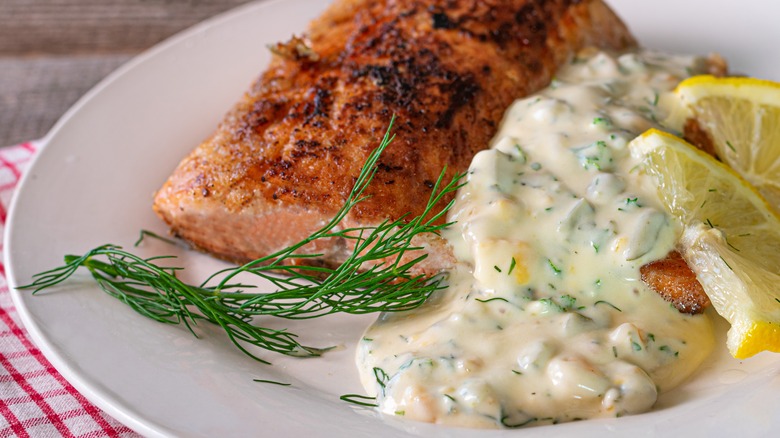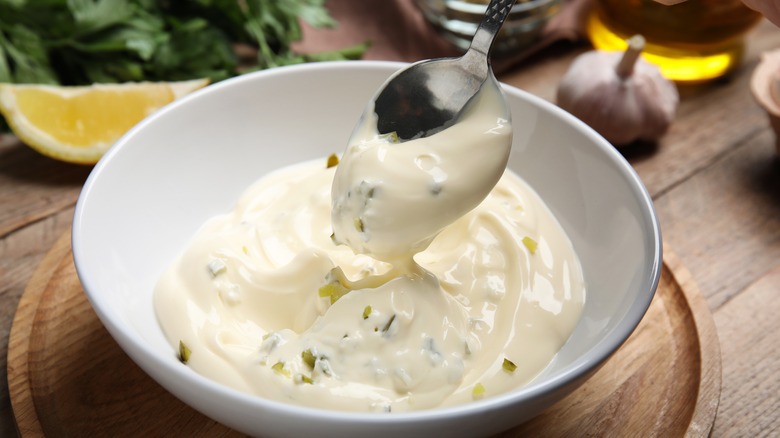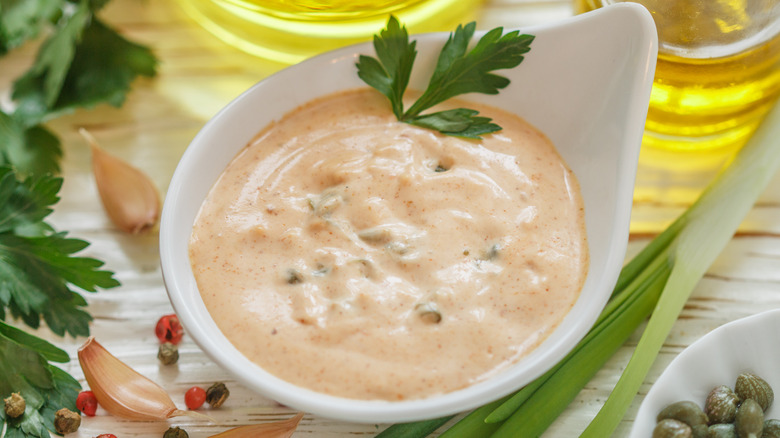The Difference Between Tartar Sauce And Remoulade
Tartar sauce is a cold mayonnaise-based sauce commonly served as a condiment with seafood (via Healthline). The same is true of remoulade sauce – or, as it's commonly known, "remoulade," according to MasterClass.
Although neither tartar sauce nor remoulade has a clear-cut origin story, it appears both were nurtured into their respective forms in France starting in the 19th century, per The Food Timeline. That makes perfect sense when you consider the raw egg-and-oil emulsion that mayonnaise was first recognized as such in France during the preceding century (via Bloomberg).
Tartar sauce is composed of a few ingredients and comprises two dominant flavors. One is tangy, thanks to the inclusion of minced pickles or capers, chopped onions, chives, scallions, and sometimes, mustard, lemon juice, or vinegar. The other is mildly sweet with the addition of sweet pickle relish. However, remoulade has additional flavor notes from any number of herbs, spices, and other embellishments, as stated by MasterClass.
Perhaps, with this comparison, some view tartar sauce as an offshoot of remoulade (per MasterClass and Food Republic). But it might be more accurate to say they're two different sauces derived from mayonnaise.
Tartar sauce involves several limited ingredients
In its form, tartar sauce essentially boils down to a handful of ingredients that aren't as customizable as those in remoulade. In fact, there were even fewer ingredients in an early version perfected by iconic French chef Georges-Auguste Escoffier during the 19th century; Escoffier's recipe used hard-cooked eggs and contained no briny bits, such as capers (via Saveur).
Escoffier's "sauce tartare" was initially developed as a dressing for raw chopped meat served by French bistros during the late 19th century. It acquired the name "steak tartare," after the Tartars of Central Asia, since their diet during the Middle Ages included raw meat, according to Brittanica. Nowadays, tartar sauce is typically served with fried seafood dishes, as either a dipping sauce (in the case of fried clams, fried oysters, and fish and chips) or as a sandwich spread for fried seafood sandwiches.
Of course, food doesn't have to be fried to go well with tartar sauce. To wit, tartar sauce-slathered burgers are a local favorite at Frisch's Big Boy in Cincinnati, Ohio (via Trip Advisor). Or you could put a dollop of tartar sauce on some classic Maryland crab cakes.
Remoulade is more customizable and offers a variety of flavors
Like tartar sauce, most remoulades begin with tangy mayonnaise, per MasterClass. But that's where the road forks — and remoulade takes an eclectic turn. As Food Republic and Saveur point out, one thing that distinguishes remoulade from tartar sauce is remoulade's near-infinite customization potential. Remoulade has been adapted for use in many global cuisines, including Cajun/Creole, Danish, and Swedish (via The Food Timeline).
According to Swedish Food, curry powder and chopped vegetables are added to make a Danish version, while Greek yogurt can be used as the base instead of mayonnaise for a Swedish-style remoulade (per True North Kitchen). And you can't forget the classic Louisiana-inspired remoulade that amps it up with garlic, horseradish, parsley leaves, Old Bay seasoning, Worcestershire sauce, and Texas Pete hot sauce, among others.
Similar to tartar sauce, remoulade works well with seafood, especially with freshly cooked lobster, as BBC Good Food points out. However, unlike tartar sauce, remoulade hasn't been typecast as a sole seafood sidekick. Other iterations include smoky bacon bits (via Louisiana Fish Fry) or anchovies for a salty, umami kick to deviled eggs, per Bon Appétit. According to Southern Living, it also makes a fine dip for crudité, complementing a variety of fresh vegetables.


